Another week, more mandates, more numbers that look mostly how one would expect, more nonsensical policies. Not much unexpected to report this week.
Executive Summary
About what you’d expect. No key takeaways this week.
Let’s run the numbers.
The Numbers
Predictions
Prediction from last week: 750k cases (-7%) and 13,800 deaths (unchanged).
Results: 703k cases (-14%) and 13,818 deaths (unchanged)
Prediction for next week: 630k cases (-10%) and 13,700 deaths (-1%).
We’ve clearly peaked on cases and are rapidly headed downward. It should still take a few more weeks before deaths start their decline, and they’re now reflecting a period where cases didn’t change much, so I expect cases to remain stable for another week or two before they start dropping.
I mentioned it last week and now I found a link to the NPR story I heard on the radio about modelers predicting things to improve steadily throughout the winter, featuring this graphical projection that I hope is essentially correct. I do agree that something like this is a baseline scenario, but it is not the mean result, because it’s highly unlikely we do much better and there are various ways things could go much worse.

Deaths
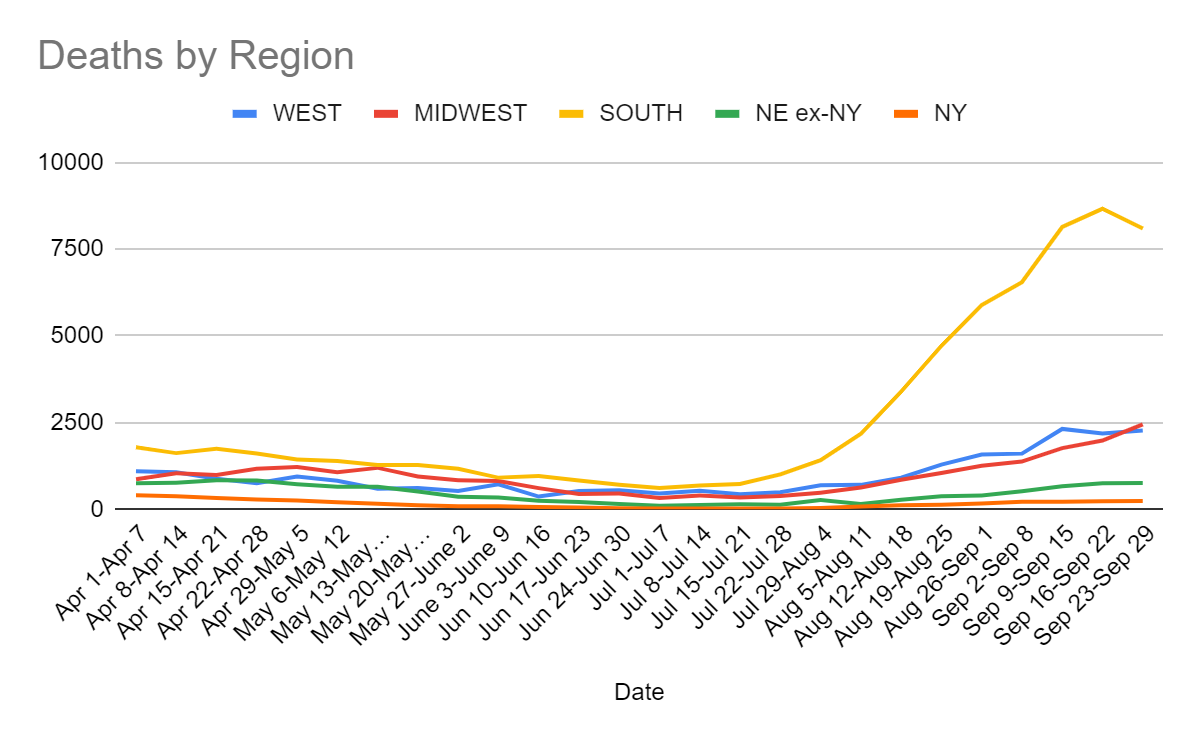

A worrisome number in the Midwest, which reflects that its cases had a jump four weeks ago. Overall this is exactly what one would have expected, and the numbers are often not smooth across regions.
Cases
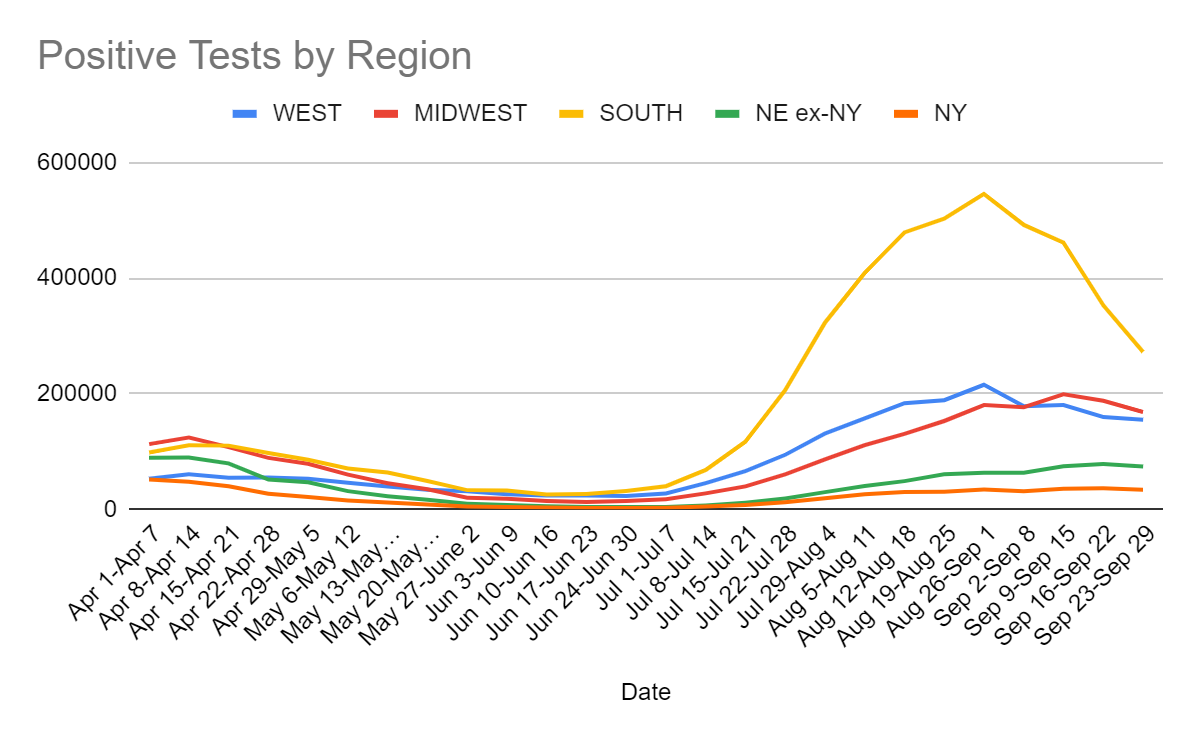

This was an even more rapid drop than expected, concentrated in a dramatic drop in the South, but with all regions falling. I don’t expect to keep up that pace, especially since the distributions have changed, but this is an excellent set of numbers.
Vaccinations
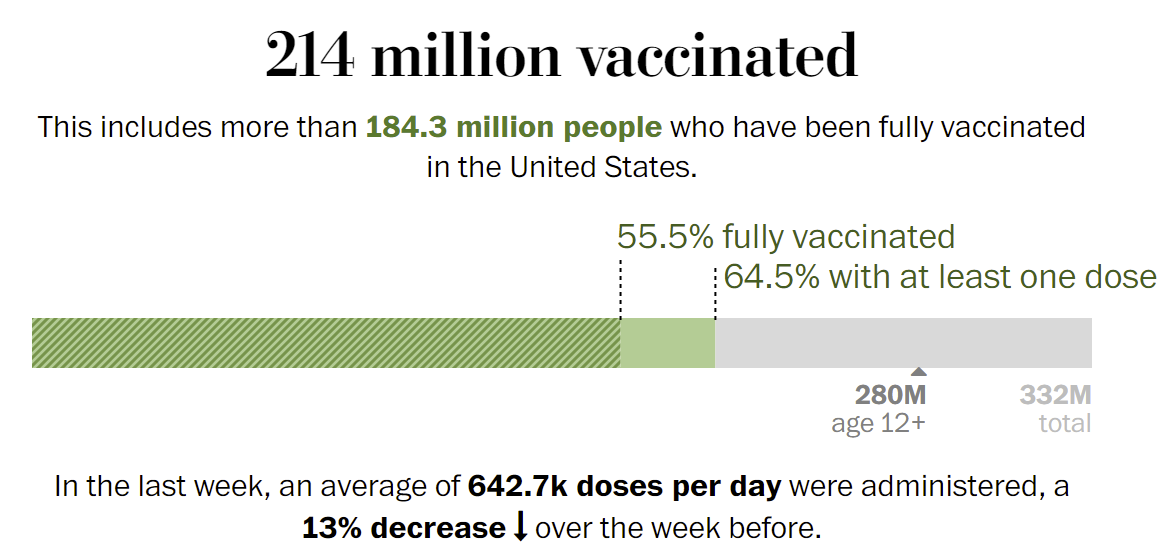
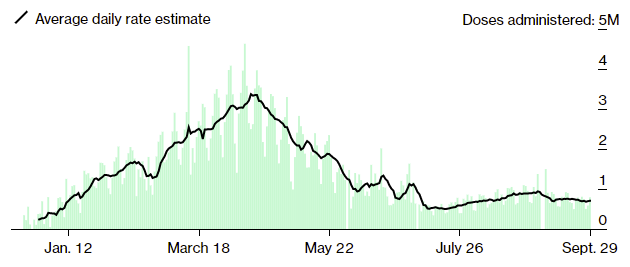
It’s interesting to think about the interaction between the vaccine mandates and new vaccinations, with new vaccinations remaining static over time. My read is that this mostly reflects that the mandates have lacked teeth, as discussed below.
Vaccine Effectiveness
We will of course never know for sure, because this information is far too important to know. A recent thread is willing to state the situation bluntly, for the general case not only for the current example. I’m going to quote extensively from it, if that’s not relevant to your interests you can skip ahead.


No one wants to do effectiveness studies. Once you know something is effective, how dare you experiment with it rather than blindly using it, that’s not ethical, and besides no one has a financial interesting in the answer once we know the thing works at all.
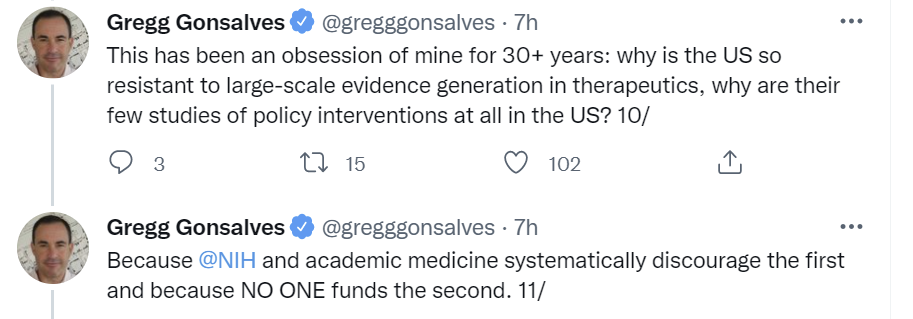
The more to-the-heart answer on policy intervention, of course, is that no one is willing to fund them and no one wants them to happen, because policy isn’t about effectiveness, so letting someone study effectiveness would interfere with policy.
Rather than having experiments be a normal thing to do, they are a Really Big Deal, and the decisions are effectively made centrally, so…
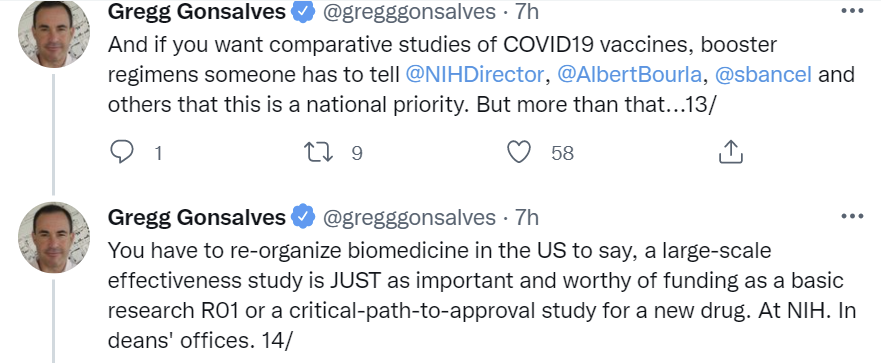
If anything, it’s decidedly more important to do effectiveness studies, since it greatly improves benefits to an intervention we’re actively doing, and most drugs we’re still studying end up not being worth using, so math.
Thus, we need to find a workaround, but workarounds are of course banned too.


Or in summary, we’re all about Following The Science, whereas finding out the right thing to do is Not Science(tm).

In summary:
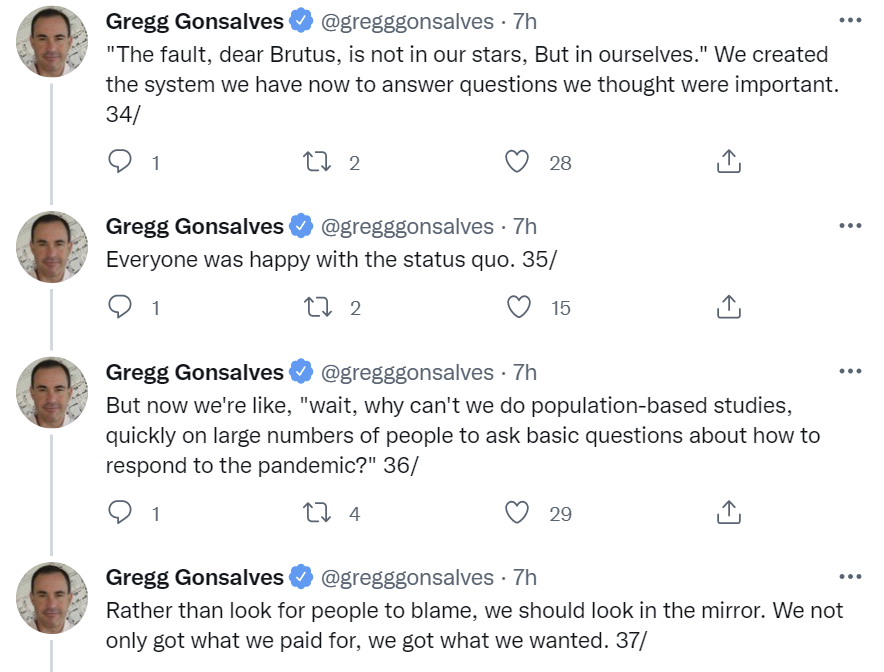
Booster Shots
Last week, the FDA declared war upon the American way of life via refusing to let most people legally have booster shots, but in its grace decided to make exceptions for the elderly, those with comorbid health conditions, and those with risky professions. The CDC then commissioned their own panel to ask the same question, and decided that this was going too far and merely being constantly exposed to Covid-19 was not a reason to further protect someone from Covid-19 beyond their initial vaccination via further vaccination, unless they were unusually likely to die. Of course, they still told those same people to wear masks all day, and distance, and otherwise live in paranoid fashion (since, again, their jobs involve seeing people all day) for much smaller gains in protection, and giving similar instructions when applicable to everyone else too, because there is a war.
Luckily, CDC director Rochelle Walensky overruled her advisory panel. She didn’t overrule it much, but she did change its recommendations to match those of the FDA, presumably because I still don’t know anyone who has said what would have happened if the two decisions hadn’t lined up with each other, and the CDC is traditionally very worried about ‘confusion,’ to the extent of refusing to allow half-dose boosters ‘to avoid confusion’ along with the even crazier ‘to avoid waste,’ and also of course not allowing mix-and-match due to no data, which cased my wife to have a very unpleasant two days getting a full-size Moderna booster. Which didn’t need to happen, if she’d been allowed to get a more reasonable booster dose or a shot of Pfizer instead.
Of course, Walensky, upon overruling her advisors, somehow had the nerve to claim she hadn’t done that.

You see, I thought about the question and took into account other evidence (that the committee had and considered as well) before making a different decision than my advisory panel, so how could you call that ‘overruling’ the advisory panel? That’s the level at which the CDC director feels obligated to say words that have meanings.
The media, of course, is no better in the other direction, as this decision was described in multiple places I saw as ‘overruling the overwhelming decision of her advisory panel,’ using basically this framing.

But of course the panel voted 9 to 6 on the question, which is the opposite of overwhelming. I’m guessing the logic was that because the votes in favor of the other permissions was overwhelming, so by extending it, she was overruling an ‘overwhelming’ decision?
Marginal Revolution offers another perspective on what these people are thinking (comments between the quotes are MR, not me).
The advisers also wrestled with the practicalities of endorsing a booster shot for only Pfizer-BioNTech recipients, when close to half of vaccinated Americans have received Moderna or J. & J. vaccines.
“I just don’t understand how, later this afternoon, we can say to people 65 and older, ‘You’re at risk for severe disease and death, but only half of you can protect yourselves right now,’” said Dr. Sarah Long, a pediatrician and infectious diseases expert at Drexel University College of Medicine in Pennsylvania.
I feel I do understand how, though of course I do not approve. Here is more from the NYT. And for a further multi-cocktail blitz of what I can only call immoral insanity:
Committee members also expressed concern on Thursday that some recommendations — particularly that certain younger Americans be allowed booster shots after an assessment of individual risks — would mean that only the wealthy and educated would gain access to additional shots.
Better that no one get such doses? Maybe so, just read further:
Some experts seemed to suggest on Wednesday that it might be better to hold off on recommending any booster shots until recipients of all three vaccines could qualify for them.
It always stuns me that grown humans think that ‘yes you did bring enough for the class but one child’s mother thinks she’s allergic to gluten so all the cupcakes need to be thrown out’ is a good argument when dealing with other grown humans. Yet here we are, time and again.
You want to know if it’s all right to mix and match booster shots? I mean, obviously it’s fine if you have a physical model of what’s going on, but presume you aren’t allowed to think like that, everything is a distinct case, and if you’re super lucky you get this…


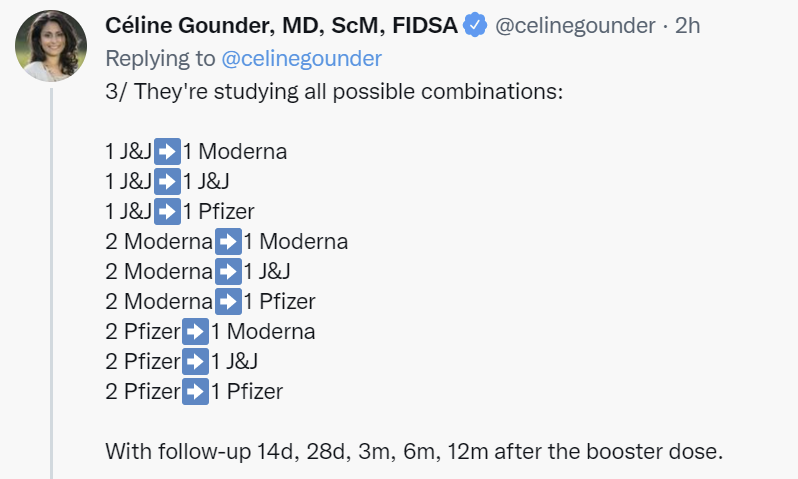
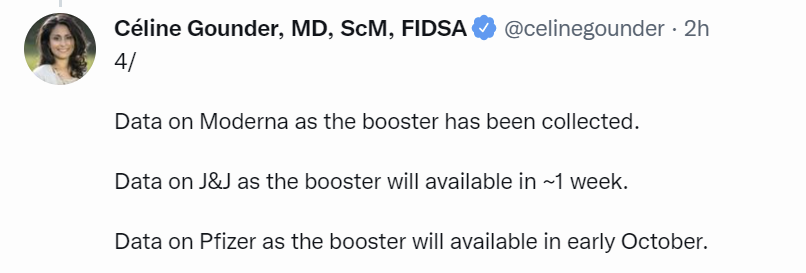
Imagine if there had been more different (well, actually mostly identical but you can’t prove anything) vaccines. We’re lucky we got to stop at nine, imagine if it were sixteen or twenty-five cases, each of which has to worry about its own p-value being less than 0.05, because that’s how they have decided knowledge works.
At first I thought those were times until the booster that needed to be studied separately because knowledge only comes in one officially prescribed form, which wouldn’t have been any more ludicrous than many other similar things, but that was my misread and it’s not quite that crazy.
Vaccine Mandates
Do mandates work? If you must choose, your money and your life, or your ability to stay unvaccinated? How’s it going, and would being an arrogant morally superior asshole about the whole thing help? It would? Great:








Here’s a Syracuse hospital where they’re reporting 96.8% compliance, and are about to suspend the remainder, which will be 122 people. They’re doing unusually well for New York, but not that unusually well.

The overall vaccination rates have risen very little since August 24, so most of the rise from 77% to 92% (let’s say the rise from 78% to 92%) is plausibly due to the mandate. That’s roughly two thirds of the remaining unvaccinated population, plus whatever happens when push comes to shove. There are doubtless some who thought ‘they’d never actually pull the trigger’ and will keep thinking that until trigger is pulled, and some of them will fold afterwards.
Here’s a North Carolina set of hospitals (WaPo), with 375 unvaccinated employees across 15 hospitals (!) and 800 clinics.
Rivers told The Washington Post that more than 99 percent of the system’s roughly 35,000 employees have followed the mandatory vaccination program.
Now that’s a high compliance rate.
It’s not only hospitals, either. United Airlines reports extremely high compliance rates as well.
United’s deadline for meeting the requirement was Monday, and the carrier said Tuesday it has begun the process of terminating 593 employees who declined to be vaccinated and did not apply for a health or religious exemption. The company said less than 3 percent of its roughly 67,000 workforce applied for exemptions, while 1 percent didn’t comply.
Even if we assume all 3% got the exemptions or will eventually be fired if they don’t, that’s still a 96% compliance rate.
Yes, as I predicted, it turns out if you raise the stakes to ‘you will lose your job’ then most people will fold rather than stand up for what they believe in. People respond to incentives, and raising the stakes from ‘don’t do a thing you don’t want to do’ into ‘don’t do a thing you don’t want to do or you’re fired’ is usually gonna do a lot of work even when it’s relatively easy to find another job. What they believe in being wrong or stupid is in no way required for this. There have been lots of righteous causes and wise preferences throughout the ages with the same pattern, as well as an even bigger pool of ignoble and stupid ones, where people often talked the cheap talk, but few walked the walk when the price was high. People don’t walk walks.
I saw this, and (aside from the question of why the person thinks this will work, which I assume it very much wouldn’t) one can either treat this as an indication that she’s willing to go to great lengths to not be vaccinated, and/or you can look at it as going to great lengths to keep her job. Or rather, to form plans to do such things, I’d guess she’s a big underdog to actually execute the plan.

Cutting the unvaccinated worker count in half still leaves quite a few workers unvaccinated, presumably willing to put up with the weekly tests and for now in many places being allowed to do that.
Some interesting selection problems here, as always. David is doubtless pointing at places where things went noticeably well. Others are looking for places where things went noticeably badly (or well), and it’s not obvious which dominates given what counts as newsworthy to different groups. What we do know is that so far, in practice, departures and disruptions due to vaccine mandates have been non-zero but minimal. A few people care enough to be loud, but the greatest power a person has, the power to say No and take the consequences, remains rare.
We’ll have more data within the week, because New York is dropping the hammer.



On the first day of the policy, zero health care facilities were forced to close, and 92% of health care workers had at least one dose.
I am always amused by language like ‘assume they are not coming to work on Monday.’ I am confident that at least some such people will come into work on Monday, and force everyone involved to be explicit that they no longer work there. It seems like the kind of thing I would do, if I the facts were different such that I was taking a stand on this. I do like the slightly staggered deadlines here, so that if they get strong evidence from the hospitals they can use that to regroup before anything happens with the schools.
This has yet to create a large bump in the graph of vaccinations, although of course it could easily be preventing a large fall-off. The anecdata suggests strongly that not many places have gotten serious about mandate enforcement yet, and that those that do see high compliance rates, sometimes very high compliance rates. So if when the mandates started we were at something like 70% of adults vaccinated, we would expect to get to 90% or more among the targeted populations. If that’s 100 million people, that’s 20 million additional vaccinations. We have 280 million adults, so that takes the adult vaccination rate from 70% to 77%, and if we assume a conservative 80% effectiveness at preventing transmission spread from vaccination that’s a 13% drop in transmission, which for Delta’s shorter interval should drop cases weekly by 25% under otherwise identical conditions. If anything that seems low. That would be quite a big game, potentially the final push necessary to bury the pandemic in many or most places.
How to reconcile these large effects with the low number of vaccinations taking place right now? My presumption is that it’s for the same reason that I can find news articles linking to particular companies and hospitals, that most places aren’t yet serious about enforcement, and people are not stupid and will wait until the mandates are going to hit them in particular before they react. The United Airlines article, for example, shows us that other airlines are taking lesser measures but aren’t following suit. Compare it to Delta Airlines directly:

As usual, you either play to win the game, or you’re less likely to win.
NPIs Including Mask and Testing Mandates
San Francisco produces worthwhile innovation, I’m as surprised as you are.

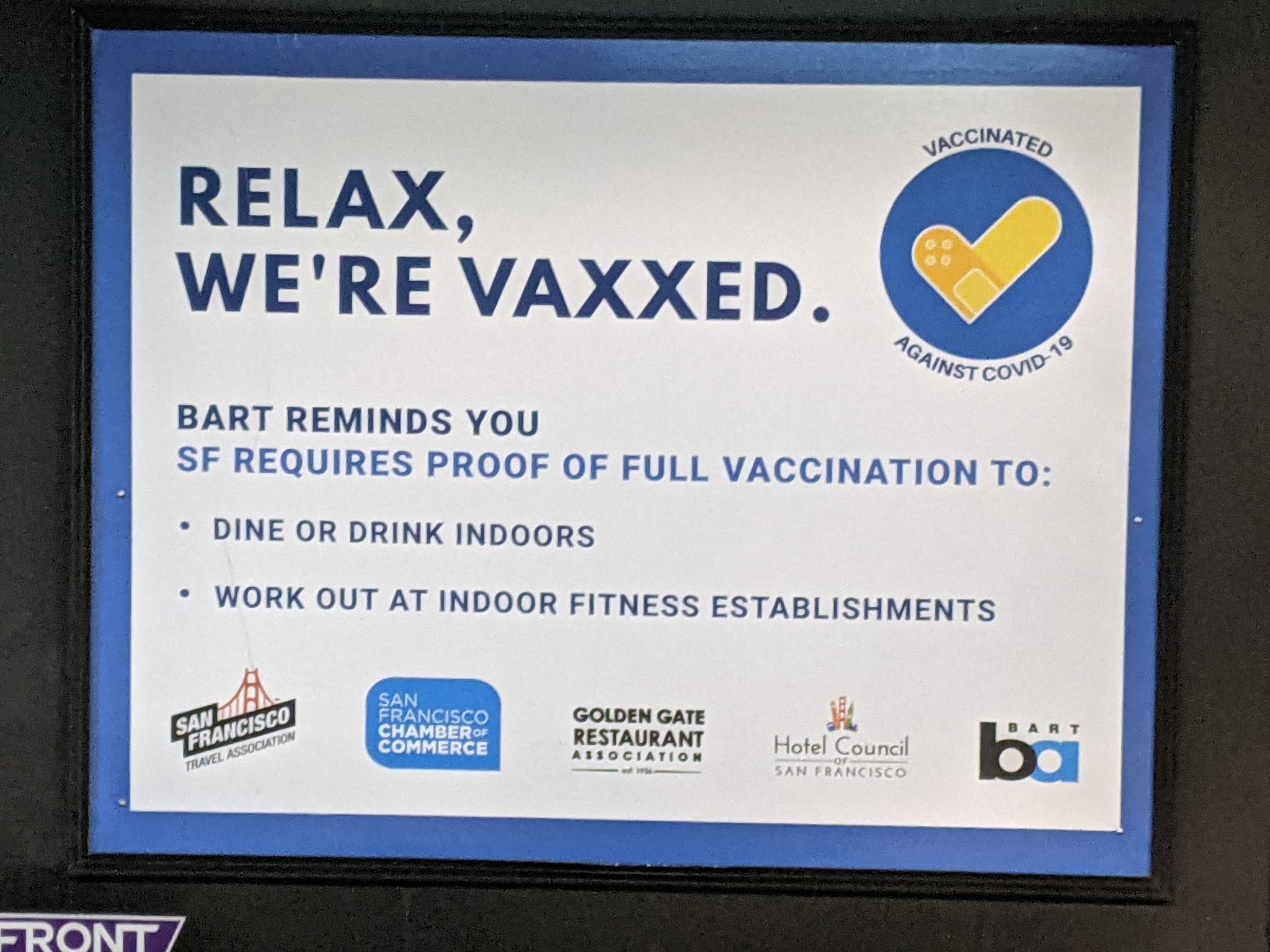
Step 1: Get Vaxxed.
Step 2: ??????
Step 3: Relax, We’re Vaxxed.
Alas, it seems like the slogan could not overcome problems with step 2.
Air filtration works exceptionally well if your goal is to avoid Covid-19. Alas, it does not perform the ritual sacrifice to the Gods, so it does not suit the goals of most people who demand what they call Covid-19 prevention.
Los Angeles sheriffs department says they won’t enforce the mask mandate.

If this were 2019 I’d be pointing out how nonsensical it is to talk about whether a given trade-off is ‘backed by science’ in this context as if science was a wise old wizard whose backing you got if you performed the proper incantations. Whereas our elites have now so abused such statements, and claimed so many things are ‘backed by science,’ that I can hardly blame Villanueva for saying it. Especially given the (rather typical) attempts later in the same news report, by the designated alarmist pro-NPI ‘experts’ to explain how things are super dangerous and we need to reinstate all the mandates right away.
The actual decision seems rather reasonable to me.

Various people are framing this as the city not having control over the Sheriff’s Department, and of course many are pointing out that ‘underfunded/defunded’ doesn’t reflect the funding levels of the department, but the core point still seems right. Resources are always limited (as they should be) and prioritization is necessary. Why should they focus on who is and isn’t wearing a mask over enforcing laws against, I don’t know, robbery, rape and murder?
If the mayor had then told them, no, let the robbers go free as long as they had their masks on properly at the time, they’re obeying the laws that count, and the Sheriff said that’s ridiculous, and the mayor said I’m the mayor and that’s what we’re going to do and the Sheriff said no, then I’d be worried all around, but until that happens I don’t see a problem in this particular case.
What is masking mostly about? Perhaps it is often not protecting from disease.

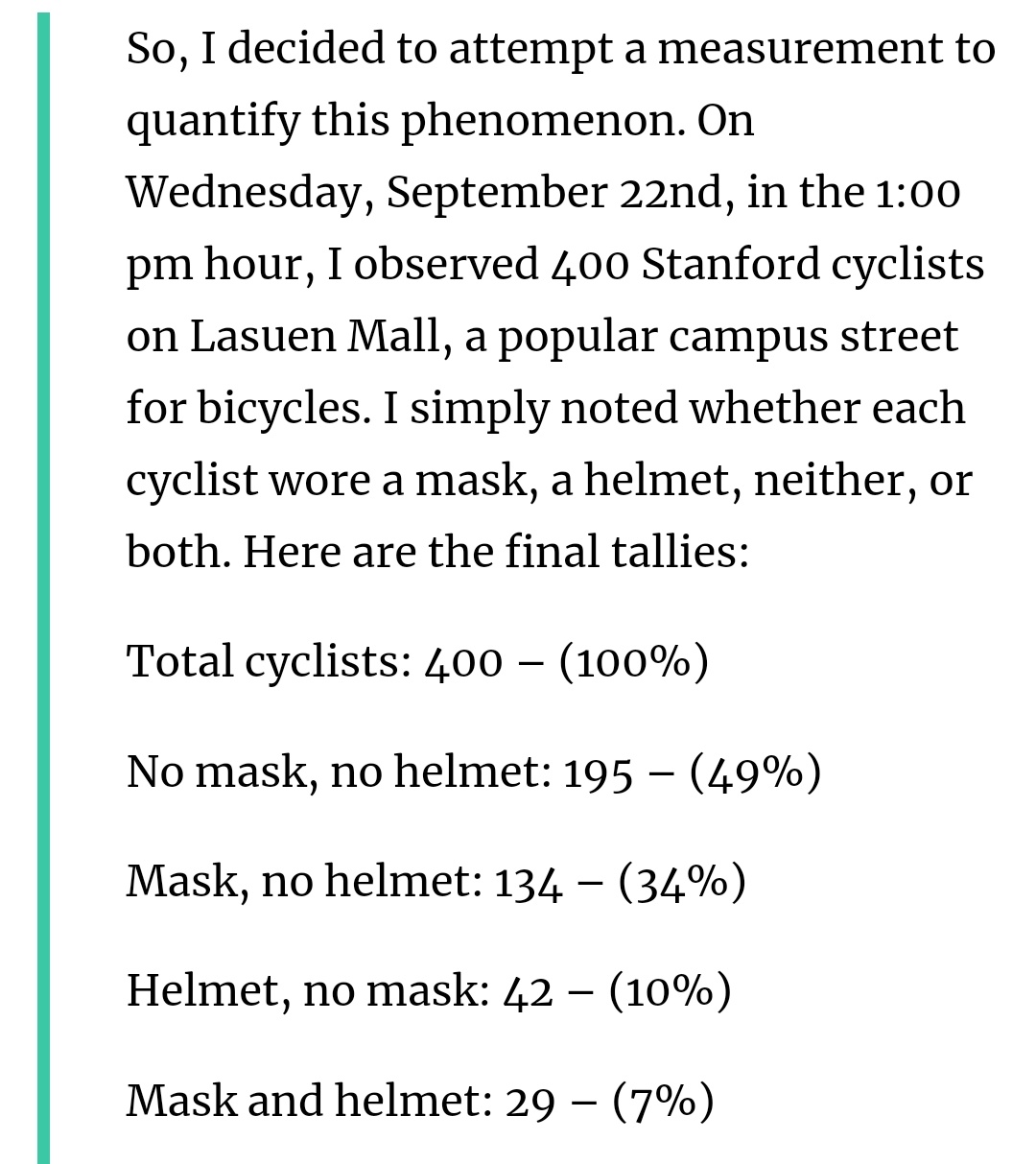
If you want to get tested for Covid-19 cheaply and quickly, I have some bad news, because the schools have demanded so many tests, and the FDA even now has so restricted our ability to supply them, that there’s none left for those who could actually benefit from them.

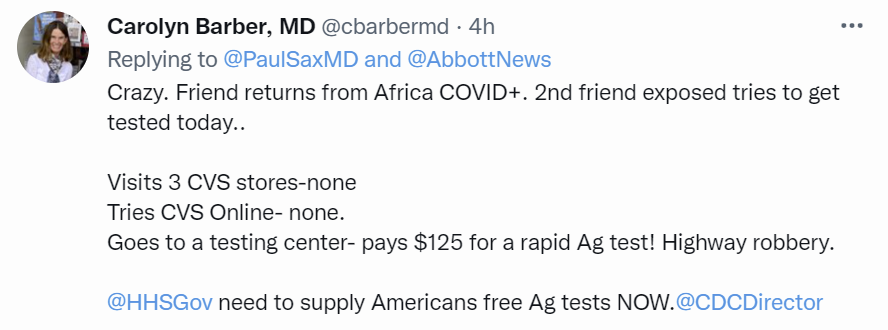
Meanwhile, an unusually clean illustration of the mindset we are supposed to have:
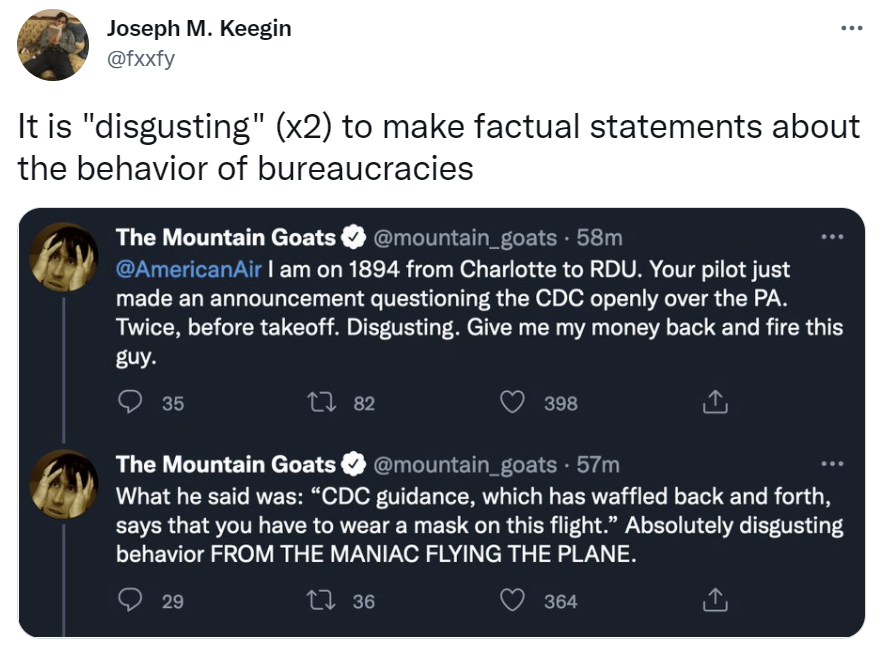
Arizona judge mandates lack of mandatory lack of mask mandates.
Australian Front
There is a war. And they’re saying the quiet part out loud.

No, seriously:
Asked if the delay in the roll out of at-home tests until vaccination rates in Australia were higher was a deliberate strategy, Professor Skerritt said “correct”.
I’m not saying such people should be on trial in the Hague, but if they were put on trial there, what would be the defense?
Think of the Children
There’s a lot of repetitive rhetoric all around, so most of this link falls under You Should Know This Already, but there’s some good concrete data in here too.

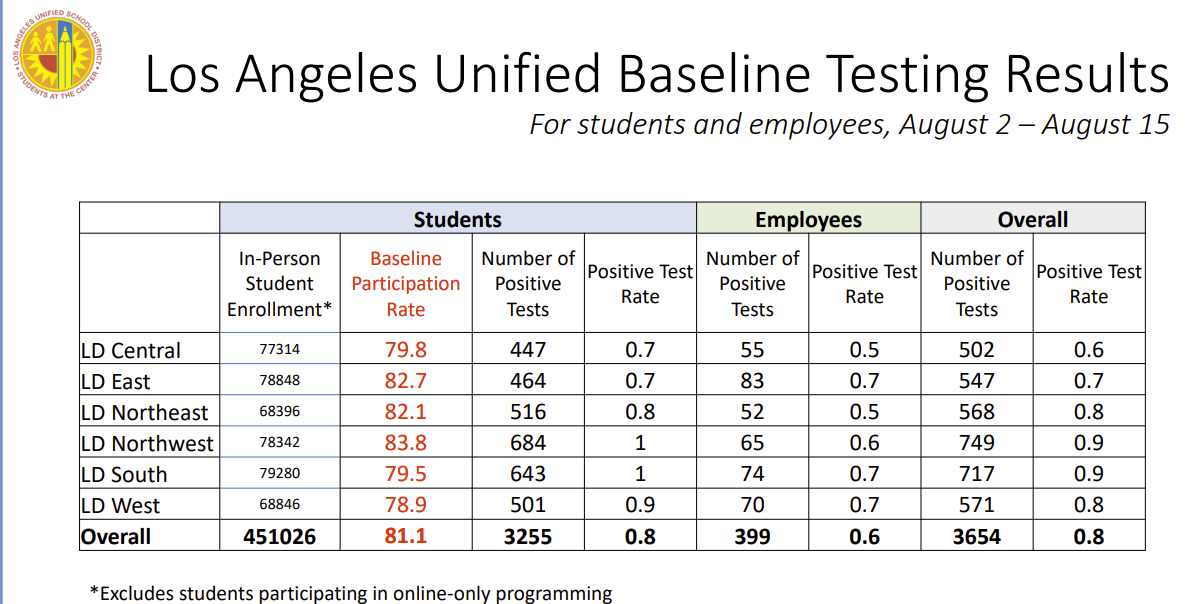
Close contacts that are not fully vaccinated, are subject to quarantine for up to 10 days after exposure to a case. Between August 15 and September 13, 15,655 student contacts and 1,056 staff contacts have been reported, with an additional 22,650 close contacts of unknown status reported, most of them suspected to be students. In total, nearly 2% of all staff and students countywide have been identified as a close contact of a case. Data to date indicates that very few of the identified close contacts have subsequently tested positive. As of last week, among the almost 30,000 people quarantined, 63 tested positive; this amounts to an overall secondary attack rate of 0.2%.
These numbers are all for Los Angeles, so it’s apples to apples.
When they did random testing before school started they got 0.8% positive test rate on random samples.
When they did testing of quarantined close contacts of positive tests that happened after school started, they got 0.2% positive tests, or 25% of the previous baseline rate.
Unless we have other competing data, this seems to be very strong evidence that schools as currently implemented in Los Angeles not only don’t make Covid-19 worse, they actively make it far better, sufficiently so that these tests are unnecessary and probably many other of their measures are as well. That’s a 75% decline in case rates, despite the new sample having known exposure.
In response to this overwhelmingly good news, the county has announced a “modified quarantine” system, whereby potentially exposed students can stay in class if they are asymptomatic and test negative twice within the ensuing seven days. This “test to stay” protocol treats quarantining as a problem more of information than infectiousness, while acknowledging the educational inadequacies and familial disruptions of remote learning.
Getting rid of the quarantines seems highly sensible given this news. The remaining testing requirement does indicate once more the extent to which are decisions on testing and prevention are far more about what would be blameworthy rather than what would prevent Covid-19. We need the tests here to tell us we’ve been responsible, rather than there being any risk, or else we’d be requiring everyone everywhere to get those same tests all the time.
There’s a teacher shortage in many places, for the obvious reason of who would want to be a teacher right now (WaPo)? Instead of being hailed as heroes, teachers are back to the usual grind, except now with the paranoia of endless useless Covid protocols, including constant mask mandates and quarantines, with crazy parents and advocates demanding contradictory things from all sides.
What to do about a shortage of teachers? A brainstormed list of solutions offers various variations on the very good idea that one should consider paying them more money, except without actually directly paying them more money.
I’ve been fortunate enough to work with a large group of superintendents tasked with generating potential solutions. Here are some of the proposed strategies:
- College loan forgiveness
- Tax breaks
- Housing assistance
- Signing and loyalty bonuses
- Limit what we expect from teachers to teaching and teaching only
- [Suggested later in the article] We have to not only defend our teachers, but praise them and elevate them to a level commensurate with the value they add to our communities.
If you want to clear a market, clear the market. Nothing wrong with housing assistance, tax breaks, loan forgiveness or signing bonuses but have you considered paying teachers more money? Why is it so hard to realize that dollars are fungible and making them less fungible is not a quality product? Presumably because they want to try and not pay much extra money and still convince people to take the deal. Whereas I’d like teachers who are qualified to teach kids to do math, having financial literacy and stand up for themselves. They’re important life skills, and we’re selecting against them. This isn’t a case of those who can’t do being able to teach, quite the opposite.
Paying teachers in respect, status and praise would be cheaper, and it’s something people value a lot, so if it can be done that’s a good idea, but calling for such things doesn’t offer a path to getting it done. We can give lip service to teachers deserving to be high status or permanently considered heroes. That won’t make it true.
That leaves limiting their job to teaching. I would suggest starting that by getting rid of the actively detrimental stuff we’ve piled into the job and experience, starting with Covid-19 related stuff, but also the far more insane policies like active shooter drills, which seems to be a way to intentionally traumatize children (and parents, and teachers) in order to make them compliant to an agenda. When people angrily point out such drills, or taking off shoes at the airport, or other such nonsense, and compare it to people who won’t get vaccinated or won’t wear a mask, they never seem to wonder if maybe that’s a sign the old other thing is stupid and we should stop, rather than evidence in favor of masks or vaccinations.
In Other News
Kelsey Piper continues exploring the reasons to be suspicious of the Ivermectin studies, and how to think about them, and how to apply that in the future to catching fraud. There’s a certain Toxoplasma of Rage logic to this being how it all looks to be turning out, on both sides, that seems a little too perfect.
Marginal Revolution highlights what happened with the CDC’s attempts to collect and use data on what was going on. I strongly agree with the post that Scott Gottlieb’s account seems likely to reflect reality and what happened, and the first account seems likely to be less good at reflecting what happened. From what I can tell, the CDC has a systematic pattern of having procedures and systems that don’t do the job that needs to be done, of refusing to share their data and findings or to upgrade their procedures, and of taking their ball and going home when anyone attempts to uses alternative sources to collect data or draw conclusions or otherwise control disease. Then they call out anyone who stands up to this as not ‘following the science’ and the media eats it up.
Meanwhile, some claims about what’s going on with the Ivermectin Facebook groups? I do worry that this might not be an accurate portrayal of what is happening, since I don’t have verification that such things are common, and it would be unsurprising if this turned out to be quite rare, but it all does make sense as a response to the incentives we’ve given such folks.
After going to rather flagrantly unconstitutional lengths to extend the moratorium on evictions, it turns out that the tsunami of evictions the moratorium was trying to prevent never materialized (WaPo). The headline says ‘experts are conflicted on why.’
Housing experts don’t believe the country has solved its eviction issues, and there are still places where evictions have risen since the ban ended. Filings have surpassed their pre-pandemic levels in Gainesville, Fla., and have come close in Cincinnati and Jacksonville, Fla.
It would be quite surprising if one couldn’t find a few places where evictions were above their pre-pandemic levels.
One hypothesis is that there might not be that much appetite for using the ‘the government said if I go to court I can stay in a place I’m not paying for’ option, because people share a common sense view about the justice of such an action, and because using the courts is difficult, confusing and deeply unpleasant.
One reason offered by tenant advocates and legal experts is that many people who fall behind on payments, particularly low income or immigrant renters who have no legal representation available, choose to “self evict.” That means they leave when their landlord tells them to or once a notice is posted on their door, rather than try to fight the eviction in court.
…
Faculty at the Georgia State University law school studied how more than 900courtshandled evictions during the pandemic. Manyrenters said they were unaware that the CDC ban existed, the researchers found, and had no idea they could have prevented their case from moving forward with legal paperwork.Other judges allowed tenants who had invoked the federal protectionsto be evicted for reasons not covered by the ban, according to Lauren Sudeall and Daniel Pasciuti of Georgia State University.
Note the implication in that second paragraph, that some judges enforced the law as written rather than simply preventing all evictions for any reason. Those bastards.
Of course, if people who couldn’t pay the rent mostly already left and the ban didn’t do much, that implies there was never a real problem in the first place. That’s certainly true in places where the rule wasn’t enforced, but where was the ‘eviction tsunami’ in those places before, a story the media would doubtless have been excited to cover?
Indeed, judges in some parts of the United States — including Ohio, Texas and Tennessee — ignored or barely enforced the eviction moratorium while it remained in place. Enforcement varied as judges gave lax interpretations of the federal ban or found ways to work around it and allow evictions to proceed.
There’s also the note that almost half of all people live in places with local eviction bans, which still apply.
The post seems filled with various reasons why the eviction ban didn’t prevent very many evictions, without then asking the obvious question: What if there never was going to be an eviction tsunami? What if we’d spent the last year and a half giving people money, and on top of that now it’s much easier to get a job than it’s been in a long time, and if it’s low-end it likely pays better than before?
Instead, demands to ‘deal with emergencies’ continue.
Top Democrats joined tenants and advocates on Capitol Hill to push for federal legislation that would further prevent evictions and protect renters. Lawmakers led by Sen. Elizabeth Warren (D-Mass.) and Rep. Cori Bush (D-Mo.) announced a new bill that would grant permanent authority to the Department of Health and Human Services to implement a moratorium in response to the pandemic or other health emergencies.
Those lawmakers continued to suggest the worst is yet to come.
Allow me to make a prediction. The worst is not yet to come. There will be no giant wave of evictions. When the bans go away, not much will happen, beyond kicking out a handful of opportunistic people who have decided to live rent-free in places they don’t own because they realized they can, and less hard-luck cases than would exist in a regular year because the low-end labor market is unusually strong. Not that this will stop media outlets from finding a few such cases, since they will always exist.
Not Covid
My Covid posts are a side project that grew far beyond anything I anticipated, but my main project remains the upcoming Tezos blockchain clean-NFT trading card game Emergents. This week was a big step for the game, as we launched our website along with my first two blog posts in the Road to Launch series, which explains much of our thinking behind the game. We also released a new promotional card, a limited 100 copy run that sold out (except for the first minted copy that’s still being auctioned) in 13 minutes at a price of 50 XTZ (currently about $275) and is now trading at a 60% premium. In many ways that’s great and exciting, but it means most of our future players didn’t have an opportunity to buy, so we’re exploring how to address that problem next time. I can’t wait to get the game into the hands of the players, watch them break it in two, rebalance, have them break it again, and repeat the cycle over the months before launch, as we also work to get the user interface where it needs to be and otherwise together make it the best game we can create. It’s an exciting time.
Also, I’ll be catching the ceremonial first pitch at Citi Field today while my lifelong friend Brian David-Marshall throws it, which isn’t quite the most amazing and memorable thing I’ve ever done, but it’s pretty far up there and I’m still not quite believing it, you know? I mean, wow, how did that even happen.

Have you received a booster yet?
One thing I am curious about regarding these mandates is most have nothing mentioned about a different case: What happen in the US if you were WFH but HAVE submitted proof of vaccination yet refuse to return to the physical work-site due to fear of breakthrough infection. Is this still grounds for termination but not in the context of vaccine refusal (as you have fully complied with the vaccine requirement)? Has this scenario played out yet?
I doubt many people are stupid enough to still decline the vaccine but there are probably plenty more who got the vaccine but don’t want to leave work-from-home status so they delayed telling their employer (I was one of these people – I proudly got both Pfizer vaccines in June but chose to delay submitting my proof to my employer on their online system until 27 September once threat of furlough to 30 Nov became more clear). I still don’t intend to return to the physical workplace and expect some negative documentation to be coming my way before the Spring 2022 semester starts as my workplace intend full return of everyone by then – though they do want some people to start returning as early as next week. I am considered a part-time employee, so I probably have close to zero rights as a part-time employee. I know I have no formal benefits nor vacation. I get renewed every semester (including summers) since Sep 2016.
The ADA requires employers to make reasonable accommodations for known disabilities. “Working from home” definitely qualifies as such. If you have a medical reason to be worried about in-office work, it might be worth talking to your doctor about getting a note for an ADA exemption.
(Note that doing this can definitely create some social friction – most companies are understanding but bad ones will just label you as a “problem” and fail to renew you next semester.)
Were companies forced to make ADA exemptions pre-COVID for immunocompromised people?
Update: BinaxNOW is now back on Amazon, on sale for ~$15 per box no less.
I didn’t realize that giant preview image was going to appear, haha
That NPR modelled uncertainty interval makes no sense to me. Next week we could have 220K-70K cases/day, but in February we’re much more confident, it’ll be between 60K and 0?
If there’s another surprise wave in store for us, it’s not going to hit next week, it’ll hit further into the future because predictions are hard, especially about the future.
Invariably every one of these models (hyped in the media) has the same basic structure,
1. Assume that cases are spread according to a SEIR model with a fixed R0
2. Model uncertainty around R0 and the % of the population with immunity.
3. Extrapolate the model out for several months.
4a. “Experts predict that COVID cases could increase by 10x in the next few months, unless we all wear a mask/ get vaccinated / social distance”
4b. “Experts predict that COVID cases will decrease by 10x in the next few months, as long as we keep wearing a mask/ getting vaccinated / social distancing”
Unfortunately and remarkably there have not been many good models produced which can accurately predict the course of the epidemic.
The CDC ensemble model has an error of ~25% in the number of deaths when predicting 4 weeks into the future. This is a bit better than just guessing deaths stay the same (~30% error) and worse than the best model (Youyang Gu at 20% error).
Bicycles: the rhetorical point largely falls flat because in the context of utility cycling in the presence of cars and trucks (as opposed to racing in an environment where no motor vehicles are present), helmets are also members of the category “mostly-useless nuisances elevated by a moral panic”. Incidentally, Australia has mandatory helmet laws.
Eviction bans: I don’t suppose that on the margin, making eviction-protection laws stronger would harm rather than benefit future tenants of the sort who might have a use for such protection? (It’s also amusing that Americans have prohibited e.g. SRO housing so effectively that, as a side effect, they mostly forgot that such a thing is possible and that it used to be a negative signal, with the result that “microapartments” are currently a hip new thing.)
I feel like the chance of a winter wave is much higher than 50%. My thinking is basically the following:
1) Covid-19 seems to have seasonal-regional patterns. For example, the regional cases per capita had the same ordering in Spring 2020 and Spring 2021 (NE > MW > S > W), as well as in Summer 2020 and Summer 2021 (S > W > MW > NE).
2) The US had a winter wave last year in all regions (well in the MW it was technically a late-fall wave, which I wouldn’t rule out happening again this year either).
3) We had multiple pre-Delta waves, but we’ve only had one Delta wave. Cases going down after a peak absolutely does not preclude another wave. I just see no strong reason to think that _now_ is the time that we’ve finally reached herd immunity and we won’t experience another seasonal wave.
4) Most people right now are either vaxxed-but-never-infected, not-vaxxed-and-never-infected, or previously-infected-but-not-vaxxed. That means there is plenty of susceptibility for another wave.
5) While we do have both higher natural immunity and higher vaccination rates than we had last winter, the same was true for this summer, and this summer wave was _worse_ than the last summer wave. Yes, that was likely mostly due to Delta, but again I don’t see why we couldn’t have another Delta wave in the winter (or, with less probability, a wave with an even more infectious variant).
Obviously my exact probability here depends on the definition of a wave, but the definition would have to be quite strict before my probability was as low as 50%.
Alternate theory on evictions…
Suppose you’re a landlord with a nonpaying tenant. You have two options:
1) Keep track of exactly how much the tenant owes, and hope that you can collect all that money when they get their life back together.
2) Evict them: give up on the uncollected money, take on immediate expenses, hope you can find a new tenant.
The pandemic pushes in favor of plan 1, both in that current nonpayment is weaker evidence of future nonpayment and in that leaving an apartment physically vacant is riskier.
So we may have a lot of voluntary non-eviction. Depending on how the economy does over the next year or so, this may or may not be the calm before a storm.
“It would be quite surprising if one couldn’t find a few places where evictions were above their pre-pandemic levels. ”
Also true when comparing eviction rates between any two random dates.
Among that sample of cyclists, the rate of mask wearing and the rate of helmet wearing are independent of each other *to within the nearest integer cyclist*. I’m not saying that’s impossible unless the data are fake, but…
The bike helmet tweet you cite seems to have as its root the mistaken idea that bike helmets make riders safer, s they are using helmet wearing as a proxy for being safety conscious. But in fact, a safety conscious bicyclist who is aware of the research would not wear helmets, so their count may show something different than they think it does.
Quick summary of research on helmets for those interested
1 – There are no gold standard double blinded studies on helmet wearing and injuries. I image this is at least in part because its hard to blind someone as to if they are wearing a helmet to not.
Conclusion: None possible here
2 – Without a gold standard double blind study, the next thing to do is look at correlations. Places without helmet mandates tend to have lower injury rates among cyclists than places with helmet mandates, so helmet mandate correlate with an increase in injury. Take this with a grain of salt though because the confounding effect is real, politicians who support helmet mandates tend to be hostile to cyclists and politicians who are hostile to cyclists design road systems where cyclists are more likely to be injured.
In places without mandates, lower helmet use correlates with lower injury rates. Again though, confounding is real and the causation could run either way or come from some third factor.
Conclusion: Suggestive that lack of helmets increases safety, but you can’t rely on it due to confounding
3 – When your correlational studies are potentially confounded, you need to look at a mechanical model of the world. Looking at injury rates for adult cyclists, there are three causes of injury that don’t round to zero. In reverse order these are, crashes by racing cyclists who are going extremely fast on downhill stretches, people doing stupid and dangerous ‘tricks’ or stunts on mountain bikes, and getting hit by cars. A commuter cyclist or anyone with good judgment can avoid races and stunts which reduce the first two risks to zero and leave the only meaningful cause of injury or death as getting hit by cars. So the question of how helmets physically cause or don’t cause safety boils down almost entirely to the question of if they increase or decrease the likelihood of car crashes.
Here, researchers have done several controlled studies where they send the same cyclist out to bike around the same neighborhoods with and without helmets. In general, they find that drivers have a lower speed when passing cyclists without helmets, and maintain larger distances between their cars and the cyclists when the cyclists don’t have helmets. These factors would all tend to reduce the risk of crashes.
Also, there is a plausible sounding case that a helmet might reduce the cyclist’s peripheral vision or awareness and make them more likely to be in a crash. Although this is plausible in theory and matches my own personal experience, studies funded by makers of bike helmets have consistently shown that helmets have no statistically significant adverse effect on peripheral vision or situational awareness; so take this causal path with a grain of salt.
Conclusion: Controlled studies seem to indicate the drivers behave in a safer fashion around cyclists without helmets and that this could translate into a lower risk of being hit and thus to higher safety.
… and after all that you now hopefully have slightly more accurate model of a very small chunk of the world
While I’m not confident either way about the effectiveness of helmets, I think you’re strawmanning the case for them. The pro-helmet claim isn’t that they’ll *prevent* car impacts, but that they’ll make car impacts *more survivable*. I’m not sure what a typical car/bike impact looks like, but perhaps a (computerized, stochastic) physics model could be useful here.
Evidence appears to be pretty overwhelming in favor of bike helmets reducing head injury.
https://pubmed.ncbi.nlm.nih.gov/29677686/#:~:text=The%20use%20of%20bicycle%20helmets,seriously%20injured%20cyclists%20by%2034%25.
The times I injured myself while cycling other than by getting hit by a car, they surely can be labelled “stupid and dangerous ‘tricks’ or stunts” *in retrospect*, but they didn’t feel like that at the time…
(e.g. attempting to cross a tramway rail at the wrong angle; I *now* know one shouldn’t to that, but there’s a number of people to whom that won’t immediately be obvious that doesn’t round to zero)
About wearing masks while bicycling at Stanford. I would guess most people are cycling short distances between indoor destinations where masks are required on both ends (dorms classrooms). It’s probably more bothersome to take off the mask and put it back on then to just wear it during the short trip.
And pockets are always a bit of a faff while cycling. (whereas your helmet won’t fit in a pocket)
I find that mask straps fit over one’s wrist quite conveniently. But I will admit that I have once or twice been seen driving with a mask on, just because I’d forgotten I was wearing it, and the drive was too short to bother removing it once I remembered.
“If anything, it’s decidedly more important to do effectiveness studies, since it greatly improves benefits to an intervention we’re actively doing, and most drugs we’re still studying end up not being worth using, so math.”
This seems like a weird place for the flip internetese “so math”: whether or not this is actually true seems 100% dependent on how you parameterize your model of study efficacy, and you provide no parameters for yours. In fact, this seems like precisely the opposite when “so math” is appropriate, surely!
Possible type: in the paragraph starting, “We’ve clearly peaked…”, should it read “… so I expect *deaths* to remain stable …” rather than *cases*?
Funny you should mention Ivermectin politics as an example of the Toxoplasma of Rage: apparently Ivermectin’s anti-parasitic action means it’s sometimes used to treat actual toxoplasmosis.
Some people even speculate that whatever minor benefit it has against covid is actually due to it treating undiagnosed toxoplasmosis (which is a major risk factor for covid severity), not due to treating the covid itself.
Then again, I found that on r/conspiracy when googling my hunch about Ivermectin treating toxoplasmosis. Weight it accordingly.
Re: Emergents, I’ve read the white paper and have a few lingering questions.
Why crypto instead of a centralized implementation of otherwise identical card objects? Expose the trading API to the public and you get the same potential for third-party marketplaces.
You make a good case that buy/sell/trade for individual cards is more consumer-friendly than Hearthstone dusting and buying packs, but why should someone who is used to the “buy the game, own the whole game” model not think this is worse?
A centralized implementation means that our records determine who owns what, so if we go down, your collection goes down with us, and if we decide to change ownership or print more (e.g. MTGO’s treasure chests) there’s no way to stop us. We want to tie our hands so we can’t do such things, and ensure that if we fail the game can continue. That’s actually what blockchain is fundamentally for – keeping a public record of what happened, that can’t be altered, only added to.
Also, the blockchain offers a lot of interoperability, marketing opportunities and synergies, and we’ve had generous support from the Tezos community on all fronts, which has helped a ton. And it makes what we’re doing a lot more legible.
Does that mean the game will be playable without depending on your servers? Also, appreciate the honesty of “TCGs are a proven great business model”.
Cards have quests and accounts have achievements, and you won’t be able to make progress on those without using our servers (or get progress towards ratings/ladders/tournaments/etc that are official, details TBD), but our full intention is that the game is playable without us once we’re ready for that, and people can change the rules of the game or deck construction or structure of events however they like.
On second thought, does blockchain actually protect you from the treasure chest problem? Even if the framework makes it impossible for you to print a second run of Volcanic Islands, I assume you’d be able to release Snow-Covered Volcanic Island and all the other workarounds people have proposed for MTG’s restricted list.
We can technically release Snow-Covered Volcanic Island but (1) people would sell back Volcanics to us and we’d pay out a lot of money in a way we can’t stop and (2) people are free to say that SCVI isn’t allowed in their games the way Old School wouldn’t allow it in MTG, and most importantly (3) if we did that, there would be a clear ‘these are the old ones, these are the new ones’ marker that people could point to, whereas on MTGO if you open a Volcanic Island now you can’t tell the difference between that and an older one unless they changed the set/art it’s filed under, and they usually don’t do that. Plus it lets other people run their own servers, etc.
Nothing is ever full protection but I do think it’s a big difference.
As for the ‘why not sell the game for one fixed price’ question, for TCGs managing one’s collection, trading/buying/selling and other similar aspects are part of the game that enhance it in various ways, and also they allow price discrimination – some players pay a lot, others play for free or almost free, still others turn a profit in various ways.
I love me a pay-once game, and think things would be better if more games, especially mobile games, went back to it, as I’ve written about, but deckbuilders in particular I think benefit from some amount of card access difficulty and from the sub/metagame of managing one’s collection, and dealing with one’s limitations. If that’s not your jam, the current model is to offer 100+ cards for free, and offer players games with only those cards allowed if someone doesn’t want to invest in the game or wants to try it first.
Also, frankly, TCGs are a proven great business model.